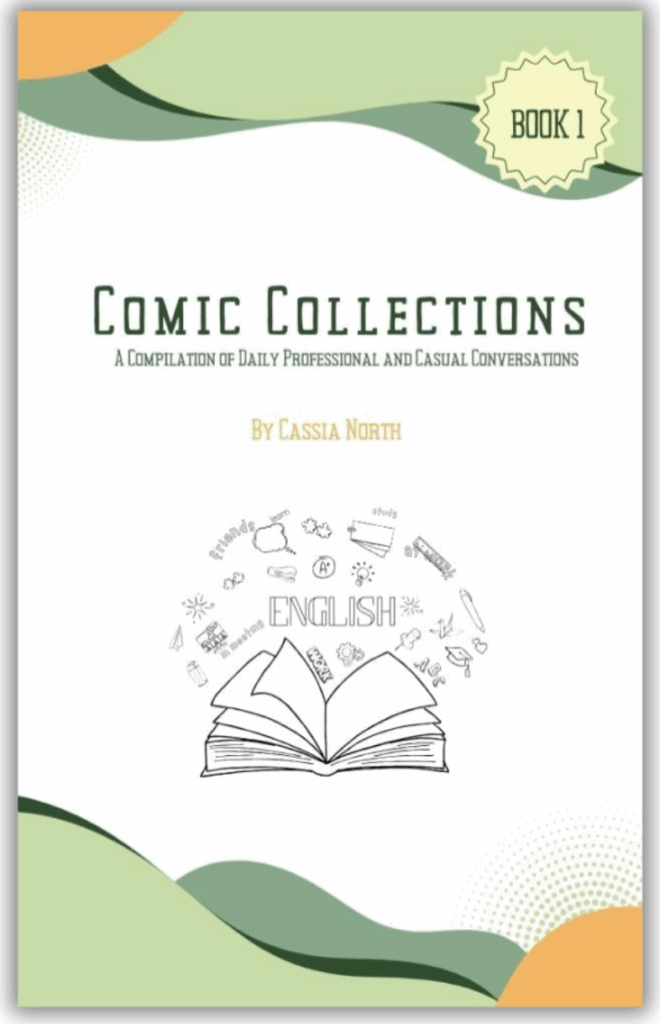
English Blogs
"Let's Learn, Explore, and Connect to the World"

Present Simple Continuous 4
- Tokita Akira
- Basic English Grammar Blog

IV. Forming Questions and Negatives in the Present Continuous Tense
Effectively using the present continuous tense involves not only making affirmative statements but also asking questions and forming negatives. This section will guide you through these essential aspects.
Forming Questions
Questions in the present continuous tense are formed by rearranging the sentence structure to place the form of ‘be’ (am, is, are) before the subject, followed by the verb in its -ing form.
Examples:

Am I speaking too fast?

Is she eating her lunch?

Are they watching the movie?
These questions are ideal for inquiring about actions in progress or current situations.
Yes/No Questions and Short Answers
For yes/no questions, the structure remains the same, and short answers usually involve the appropriate form of ‘be’ (am, is, are).
Examples:

Question: Are you learning English?
Short Answer: Yes, I am. / No, I’m not.

Question: Is he working today?
Short Answer: Yes, he is. / No, he isn’t.
Forming Negative Sentences
To make negative sentences in the present continuous tense, ‘not’ is added after the form of ‘be’ and before the verb-ing.
Examples:

I am not (I’m not) reading that book.

She is not (isn’t) coming to the party.

They are not (aren’t) playing football right now.
These negatives are used to deny actions or situations that are happening at the moment or to negate temporary situations.
Common Mistakes to Avoid
Incorrect Verb Form: Ensure the main verb ends in -ing. For example, “He is cook” is incorrect; it should be “He is cooking.”
Misplacing ‘Not’: Remember that ‘not’ should follow ‘am’, ‘is’, or ‘are’. A common mistake is placing it after the main verb.
Overuse in Inappropriate Contexts: Be cautious not to overuse the present continuous for situations that are permanent or habitual, which require the present simple tense.
Conclusion
 Understanding how to correctly form questions and negatives in the present continuous tense is crucial for effective communication. It allows for a more dynamic and varied expression, essential in both spoken and written English. In the next section, we will delve into practical tips for using this tense and common mistakes to be aware of.
Understanding how to correctly form questions and negatives in the present continuous tense is crucial for effective communication. It allows for a more dynamic and varied expression, essential in both spoken and written English. In the next section, we will delve into practical tips for using this tense and common mistakes to be aware of.
Latest Blogs

Present Simple Tense 1
English Blogs “Let’s Learn, Explore, and Connect to the World” Present Simple Tense 1 I. Introduction to the Present Simple Tense in English Mastering the

Present Simple Tense 2
English Blogs “Let’s Learn, Explore, and Connect to the World” Present Simple Tense 2 II. Understanding the Present Simple Tense Definition and Structure At its
Reading comprehension quiz
Check out our books and more!

Travel English: A Compilation of Key English Conversations When Traveling
Explore the world confidently with ‘Travel English’ by Allison Kate, a comic-style guide full of essential conversations and tips for every traveler. Speak English with ease in airports, hotels, and more!
Check out our Blogs!
Read our everyday blogs and gain new knowledge, skills, and inspiration to support your learning journey here in SEKAEL.


Explore Mental Health Blogs to gain insights and tips on self-care, emotional balance, and personal well-being.

















 The present continuous tense, with its wide range of applications, is a fundamental aspect of conversational and written English. Its ability to describe ongoing actions, temporary situations, future plans, express annoyance, and indicate changes makes it an indispensable tool in the English language. Grasping these varied uses enhances one’s ability to engage in more dynamic and nuanced communication.
The present continuous tense, with its wide range of applications, is a fundamental aspect of conversational and written English. Its ability to describe ongoing actions, temporary situations, future plans, express annoyance, and indicate changes makes it an indispensable tool in the English language. Grasping these varied uses enhances one’s ability to engage in more dynamic and nuanced communication.










 Grasping the formation and functions of the present continuous tense is a fundamental step in mastering English grammar. It allows learners to accurately describe ongoing actions and situations, enhancing their ability to communicate effectively. In the following sections, we will delve deeper into the usage of this tense, focusing on forming questions, negatives, and providing practical examples.
Grasping the formation and functions of the present continuous tense is a fundamental step in mastering English grammar. It allows learners to accurately describe ongoing actions and situations, enhancing their ability to communicate effectively. In the following sections, we will delve deeper into the usage of this tense, focusing on forming questions, negatives, and providing practical examples.






 Fundamentally, the present continuous tense is used to describe actions that are happening at the very moment of speaking. It paints a picture of activities in progress, allowing the speaker to convey a sense of immediacy and involvement. This aspect of the English language is particularly important for non-native speakers to grasp, as it adds a layer of precision and realism to descriptions of everyday events and experiences.
Fundamentally, the present continuous tense is used to describe actions that are happening at the very moment of speaking. It paints a picture of activities in progress, allowing the speaker to convey a sense of immediacy and involvement. This aspect of the English language is particularly important for non-native speakers to grasp, as it adds a layer of precision and realism to descriptions of everyday events and experiences. The present continuous tense is not just limited to expressing actions occurring in the present. It also extends to cover temporary situations, emerging trends, and future plans, making its understanding and correct usage vital for anyone looking to achieve fluency in English. For learners, particularly those from Asian backgrounds where tense forms might differ significantly, mastering the present continuous tense can be both challenging and rewarding. It requires not only a grasp of its grammatical structure – involving the present tense of the verb ‘to be’ and the present participle (verb-ing form) – but also an understanding of its appropriate contextual usage.
The present continuous tense is not just limited to expressing actions occurring in the present. It also extends to cover temporary situations, emerging trends, and future plans, making its understanding and correct usage vital for anyone looking to achieve fluency in English. For learners, particularly those from Asian backgrounds where tense forms might differ significantly, mastering the present continuous tense can be both challenging and rewarding. It requires not only a grasp of its grammatical structure – involving the present tense of the verb ‘to be’ and the present participle (verb-ing form) – but also an understanding of its appropriate contextual usage. In this article, we will delve into the formation, uses, and nuances of the present continuous tense. We aim to provide a comprehensive guide that simplifies this tense for beginners, enriched with practical examples and tips. By the end of this piece, learners will have a clearer understanding of how to use the present continuous tense to describe ongoing actions, temporary situations, and future arrangements, thereby enhancing their proficiency and confidence in using the English language.
In this article, we will delve into the formation, uses, and nuances of the present continuous tense. We aim to provide a comprehensive guide that simplifies this tense for beginners, enriched with practical examples and tips. By the end of this piece, learners will have a clearer understanding of how to use the present continuous tense to describe ongoing actions, temporary situations, and future arrangements, thereby enhancing their proficiency and confidence in using the English language.

 Daily Journaling: Start a daily journal where you write about your day, your routines, and observations. This practice will help reinforce the use of the present simple in describing habitual actions and facts.
Daily Journaling: Start a daily journal where you write about your day, your routines, and observations. This practice will help reinforce the use of the present simple in describing habitual actions and facts. Role-playing Scenarios: Engage in role-playing activities with friends or language partners. Create scenarios where you can use the present simple, such as simulating a teacher explaining a concept or a tour guide describing historical places.
Role-playing Scenarios: Engage in role-playing activities with friends or language partners. Create scenarios where you can use the present simple, such as simulating a teacher explaining a concept or a tour guide describing historical places. Online Quizzes and Exercises: Utilize online resources that offer quizzes and exercises focused on the present simple tense. These interactive tools provide immediate feedback, helping you learn from mistakes and improve.
Online Quizzes and Exercises: Utilize online resources that offer quizzes and exercises focused on the present simple tense. These interactive tools provide immediate feedback, helping you learn from mistakes and improve. Conversations: Try to consciously use the present simple in daily conversations, especially when talking about routines, habits, or general truths.
Conversations: Try to consciously use the present simple in daily conversations, especially when talking about routines, habits, or general truths. Listening and Mimicking: Listen to native speakers in movies, TV shows, or podcasts, and mimic their use of the present simple. This practice helps in understanding the context in which this tense is used.
Listening and Mimicking: Listen to native speakers in movies, TV shows, or podcasts, and mimic their use of the present simple. This practice helps in understanding the context in which this tense is used. Reading and Analysing: Regularly read English newspapers, magazines, or books, and pay special attention to the use of the present simple tense. Analyzing how it’s used in different contexts can deepen your understanding.
Reading and Analysing: Regularly read English newspapers, magazines, or books, and pay special attention to the use of the present simple tense. Analyzing how it’s used in different contexts can deepen your understanding.


 While the present simple tense might seem straightforward, effectively using it and avoiding common pitfalls can be challenging. Here, we provide practical tips for proper usage and highlight some typical mistakes learners often make.
While the present simple tense might seem straightforward, effectively using it and avoiding common pitfalls can be challenging. Here, we provide practical tips for proper usage and highlight some typical mistakes learners often make.



 Understanding when and how to use the present simple tense is key to mastering English grammar. By being mindful of common errors and practicing regularly, you can enhance your English communication skills significantly. Keep these tips in mind as you continue to explore and use the English language in your daily life.
Understanding when and how to use the present simple tense is key to mastering English grammar. By being mindful of common errors and practicing regularly, you can enhance your English communication skills significantly. Keep these tips in mind as you continue to explore and use the English language in your daily life.

 Mastering the art of forming questions and negatives is a crucial aspect of using the present simple tense effectively. This section will guide you through the rules and nuances of constructing these types of sentences.
Mastering the art of forming questions and negatives is a crucial aspect of using the present simple tense effectively. This section will guide you through the rules and nuances of constructing these types of sentences.





















 The
The 






 One crucial aspect of the present simple tense is subject-verb agreement. This rule states that when the subject is a third-person singular (he, she, it), the verb typically ends in -s or -es. This rule is one of the key differences that sets English apart from many Asian languages, which often do not have such distinctions in verb forms based on the subject.
One crucial aspect of the present simple tense is subject-verb agreement. This rule states that when the subject is a third-person singular (he, she, it), the verb typically ends in -s or -es. This rule is one of the key differences that sets English apart from many Asian languages, which often do not have such distinctions in verb forms based on the subject.




 The present simple tense is more than just a grammatical rule; it is a key to unlocking the richness of the English language. Its simplicity allows for versatility in expression, from describing daily routines to stating universal facts. This tense is ubiquitous, appearing in conversations, written narratives, news reports, and instructions, making it one of the first aspects of English grammar that beginners encounter and must master.
The present simple tense is more than just a grammatical rule; it is a key to unlocking the richness of the English language. Its simplicity allows for versatility in expression, from describing daily routines to stating universal facts. This tense is ubiquitous, appearing in conversations, written narratives, news reports, and instructions, making it one of the first aspects of English grammar that beginners encounter and must master. This article aims to demystify the present simple tense, providing learners with a comprehensive understanding of its structure, usage, and application. By delving into its various aspects, from forming affirmative sentences to asking questions and making negatives, we will explore how this tense shapes the foundation of English communication. Through practical examples and tips, we aim to equip learners with the knowledge and confidence to use the present simple tense effectively, paving the way for fluency in English.
This article aims to demystify the present simple tense, providing learners with a comprehensive understanding of its structure, usage, and application. By delving into its various aspects, from forming affirmative sentences to asking questions and making negatives, we will explore how this tense shapes the foundation of English communication. Through practical examples and tips, we aim to equip learners with the knowledge and confidence to use the present simple tense effectively, paving the way for fluency in English.